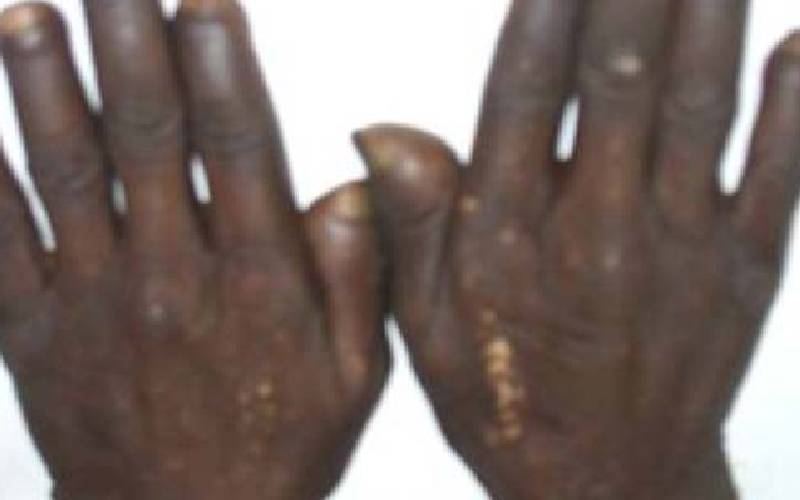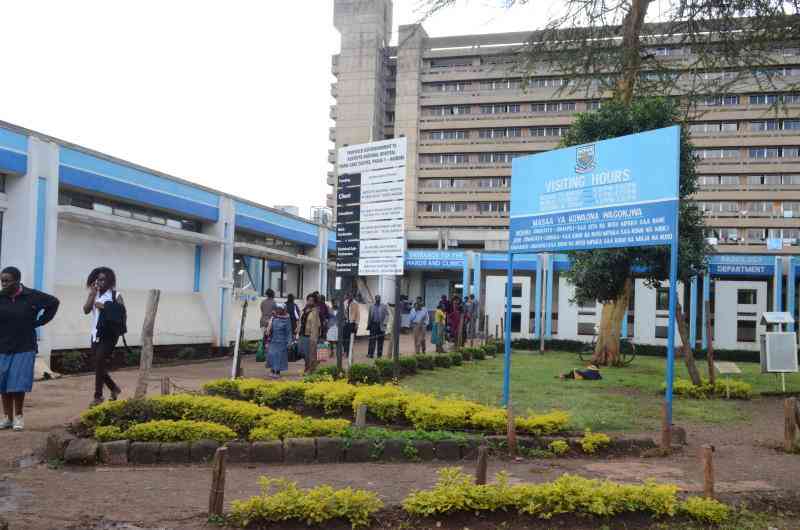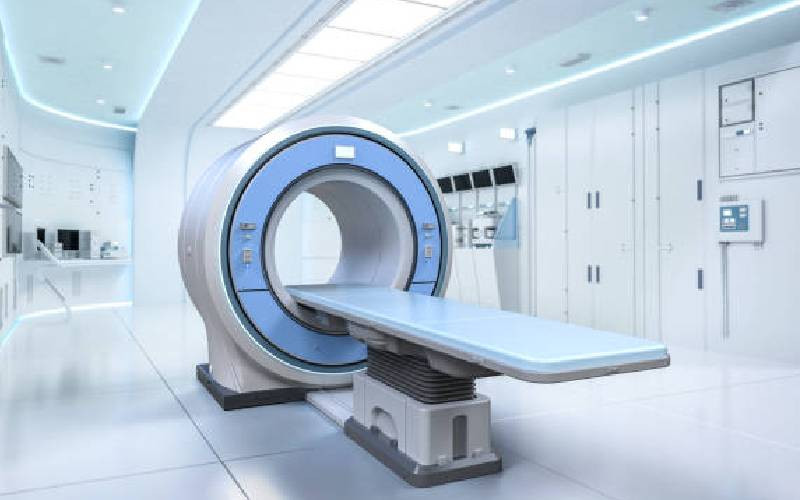
Eunice Wanjiku was born healthy but at age five, her mother Teresia Mukami noticed that her eyes were yellowish in colour. Her skin was also developing sores.
“They soon turned into wounds that were oozing a clear fluid and my daughter could not walk anymore,” she recalls.
Teresia then took her child to Kijabe hospital for a review but was referred to Kenyatta National Hospital where she was diagnosed with a rare condition called scleroderma.
“She was mostly surviving on pain killers and could not feed well as her mouth also had sores,” Teresia tells My Health.
According to Dr Eugene Genga, a rheumatologist, scleroderma is an autoimmune disease that affects the skin and other organs of the body, meaning that the body’s immune system causes inflammation and other abnormalities in these tissues.
“It often leads to skin tightening and thickening and may affect the heart, lungs, kidneys, blood vessels or intestines. The word scleroderma comes from two Greek words: “sclera” meaning hard, and “derma”, meaning skin. Hardening of the skin is one of the most visible manifestations of the disease,” he explains.
This is a long-term disease that happens when the immune system causes the body to make too much protein collagen. As a result, the skin gets thick and tight and hard. Scars form on the lungs and kidneys as well.
This is, however, not a contagious disease and there is no cure for it. The only way is to manage the symptoms to ensure a good quality of life.
According to Genga, there are no studies locally on the prevalence of this disease in Kenya.
“The only study available was done by one of our colleague’s, Dr Syokau (lecturer now at University of Nairobi) in 2011, where she looked at records at Kenyatta National Hospital between 2001 and 2011 and found only 50 patients. This shows how rare this disease is. The numbers have increased partly due to more awareness about this illness,” he explained.
This condition, he points out, is more common in women between the ages of 30 and 50.
Causes of scleroderma?
Scleroderma results from an overproduction and accumulation of collagen in body tissues. Collagen is a fibrous type of protein that makes up your body’s connective tissues, including your skin.
“We still don’t know exactly what causes the abnormal collagen production to begin, but the body’s immune system appears to play a role. It is suspected that scleroderma is caused by a combination of factors, including immune system problems, genetics and environmental triggers,” Genga says.
Stay informed. Subscribe to our newsletter
Earliest symptoms
There are many different types of scleroderma. It is broadly classified into two - local and systemic. In some people, scleroderma affects only the skin (localised). But in many people, scleroderma also harms structures beyond the skin, such as blood vessels, internal organs and the digestive tract (systemic scleroderma). Signs and symptoms vary, depending on which type of scleroderma you have.
One of the earliest symptoms is Raynaud’s. This term refers to colour changes (blue, white and red) that occur on fingers and sometimes toes.
Genga says this occurs when the small blood vessels in your fingers and toes contract often after exposure to cold temperatures or emotional distress causing blood flow to the hands and fingers to be temporarily reduced. When this happens, your fingers or toes may turn blue or feel painful or numb. Raynaud’s disease also occurs in people who don’t have scleroderma.
“Other symptoms include skin thickening, swelling and tightening, joint pain and calcium deposits in the skin or other areas. It can progress to involve the gastrointestinal tract causing heartburn, bloating and in the chest causing shortness of breath and dry cough,” he adds.
“There is not a blood test that can say for sure that you have scleroderma, although numerous antibodies have been associated with this condition. I feel that emphasis should be on who to suspect because this disease has such a varied presentation and if found late can have permanent long-term complications,” says Genga.
The most common first sign of scleroderma is Raynaud’s phenomenon. Skin thickening is the next most obvious physical finding to make a diagnosis of scleroderma.
Other symptoms that should raise an index of suspicion include fatigue, weight loss, musculoskeletal pain, gastrointestinal reflux disease (GERD), nail fold capillary changes, oedema in the extremities or obvious skin thickening. These clues should warrant an early visit to your doctor or rheumatologist for further evaluation. It’s sad that most of our patients are diagnosed late after the complications of skin thickening or hardening have set in, which at times are irreversible.
Managing and living with scleroderma
Due to the challenging and multisystemic nature of scleroderma, it may require a large team of specialists led by the rheumatologist. The team may include dermatologists, pulmonologist, gastroenterologist, cardiologist, nutritionist and physiotherapist. The aim of treatment is to relieve symptoms, prevent the condition getting worse, detect and treat any complications (such as pulmonary hypertension), and help you maintain the use of affected parts of the body.
“Some of the common treatments include medication to improve circulation, blood pressure medication and medicines that reduce the activity of the immune system and slow the progression of the condition,” Genga explains.
Patients may also get steroids to relieve joint and muscle problems as well as moisturisers for affected areas of skin to help keep it supple and relieve itchiness. There are various medicines used to control other symptoms such as pain, heartburn and high blood pressure.
There are many therapies and lifestyle changes that can help reduce the impact of scleroderma on your life. Among them is regular physiotherapy and stretching exercises. These help keep the muscles supple and loosen tight skin. An occupational therapist can help a patient adapt to any movement difficulties by suggesting changes to the home and equipment to make daily life easier.
“If you are affected by Raynaud’s, you’ll need to keep your hands and feet warm in the cold by wearing thick gloves and socks. Also, it’s important to eat healthily, exercise regularly and stop smoking to keep blood pressure under control and improve circulation,” he adds.
Teresia now has to regularly go to the hospital to get her daughter checked as well as get medication to manage her condition.
“She has greatly improved now, the wounds have dried up, all we do is ensure she sees her doctors regularly to ensure she lives a comfortable life.”
Her latest update from the doctor came just last week and was impressive!
“I am very happy that the doctors are seeing progress with the child. At 13 years she has added weight and is now weighing 16 kilogrammes from 10 when she was 11 years old. She can also move around, which is very good. She crawls and can take herself to the bathroom and dress herself,” says an elated mother, adding that she has seen Eunice’s wounds healing gradually.
“Right now only the arms and parts of the face have few wounds. The mouth sores have totally cleared up and the child can now feed comfortably,” she adds.
 The Standard Group Plc is a
multi-media organization with investments in media platforms spanning newspaper
print operations, television, radio broadcasting, digital and online services. The
Standard Group is recognized as a leading multi-media house in Kenya with a key
influence in matters of national and international interest.
The Standard Group Plc is a
multi-media organization with investments in media platforms spanning newspaper
print operations, television, radio broadcasting, digital and online services. The
Standard Group is recognized as a leading multi-media house in Kenya with a key
influence in matters of national and international interest.
 The Standard Group Plc is a
multi-media organization with investments in media platforms spanning newspaper
print operations, television, radio broadcasting, digital and online services. The
Standard Group is recognized as a leading multi-media house in Kenya with a key
influence in matters of national and international interest.
The Standard Group Plc is a
multi-media organization with investments in media platforms spanning newspaper
print operations, television, radio broadcasting, digital and online services. The
Standard Group is recognized as a leading multi-media house in Kenya with a key
influence in matters of national and international interest.










